Hiroshima Immediately after the Bombing
How did the victims escape and where did they go?
The A-bomb had instantaneously destroyed most of the city, causing enormous fires and chaos. Those who could move emerged from the rubble and fled for their lives towards the outskirts.
About 150,000 people, including the injured transported by military truck or train, fled to Aki, Asa, Saeki and other areas outside the city. Ujina Port, in the southern part of the city, was in a state of mass confusion as people scrambled to seek refuge with relatives on islands in the Seto Inland Sea.
Those taking in refugees were overwhelmed by relief efforts and pandemonium ensued.
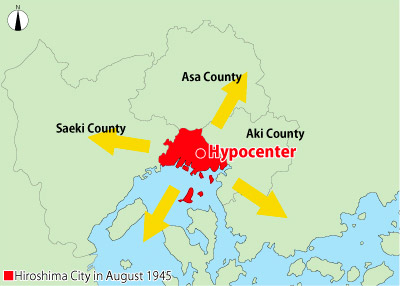
Source: “Ninoshima – Hiroshima and Hiroshima”
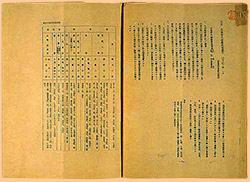
Hiroshima City Mass Evacuation Summary
In April 1945, the city of Hiroshima released its mass evacuation summary.
The summary indicated that in the event of a large fire in the city resulting from air raids the different neighborhood associations would evacuate to villages in Saeki, Asa, and Aki counties and that emergency food and medical supplies needed for the evacuees would be stored in advance at the indicated evacuation areas.
Donated by Hiroshi Naganuma
Relief Activities after the Bombing
On the sixth, staff at Army Marine Headquarters (commonly known as the Akatsuki Corps) about 4 km from the hypocenter, other military personnel, police officers, and doctors, many from outside the city, carried out rescue work, dispensed first aid, received corpses, and distributed rice.
The hospitals and medical facilities around Hiroshima that managed to escape the fires and temporary first-aid stations set up throughout the area were all overflowing with casualties. Almost all of the doctors and nurses were victims of the bombing and medical supplies were destroyed. The injured seeking help were unable to receive adequate medical care; they died one after the next. Meanwhile, casualties continued arriving at the first-aid stations, calling throughout the night for their relatives or for help.
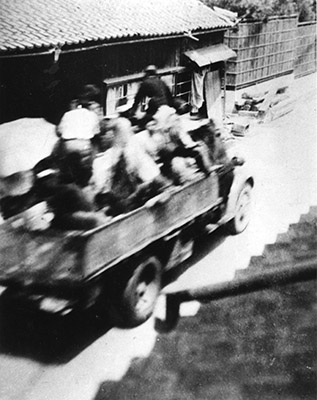
A truck carrying injured from the city
Immediately after the bombing, injured people were carried by truck to safety in the suburbs.
August 6, 1945, afternoon
Photo by Mitsuo Matsushige
Courtesy of Association of the Photographers of the Atomic (Bomb) Destruction of Hiroshima
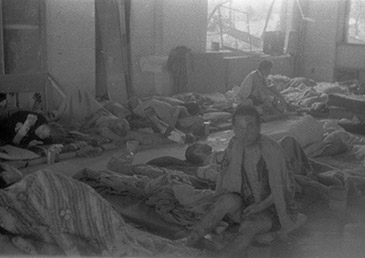
People taken in by hospitals
The Hiroshima Red Cross Hospital was located about 1,500 meters from the hypocenter.
Hospital rooms, with their window frames blown out, were exposed to the outside, and many injured laid on the thin futons that had been spread out closely across the floor.
Hospital staff, they themselves injured, provided round the clock care for victims.
August 9-12, 1945
Photo by Hajime Miyatake
Courtesy of Asahi Shimbun
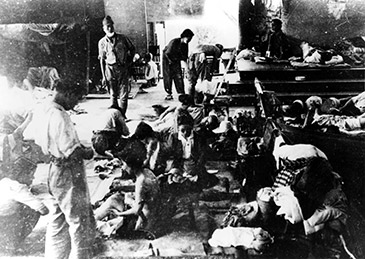
Relief Station at First Elementary School
Because the First Elementary School (now, Hiroshima Municipal Dambara Junior High School) was undamaged by fire, it served as a relief station until October, with part of the schoolyard serving as a temporary crematorium.
Around August 7-20, 1945
Photo by Army Marine Headquarters Photographer’s Unit
Courtesy of Hiroshima Atomic Bomb Casualty Council
Rice Ball Strategy
On the seventh, rice balls arrived from surrounding towns and villages.
Many were distributed to people who had collapsed along the roads, but some had no energy to eat and just held on to the rice balls.
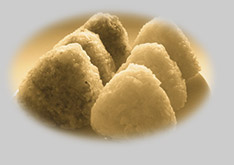
Of all the plans the Defense Headquarters had put in place, the rice ball plan was the only one we actually carried out.
(omitted)
I listened closely. “I’m going to talk to the chiefs in Kaita-ichi, Kabe and Hatsukaichi. I’ll have them work with the towns and villages in their precincts. In the event of air raid, those communities will make rice balls and run them to Hiroshima. The city can pay for the rice later. What do you think?”
(omitted)
Thanks to that rice ball strategy, for ten days after the disaster, we did not worry that the people of Hiroshima were deprived—at least of their staple food.
Nor can we forget the good hearts of the villagers and town people who toiled to make those balls and get them to us. A special thanks to those who, in that chaos, took extra steps to make rice balls that would last in the summer heat.
From “A-bomb Mayor” by Shinso Hamai
